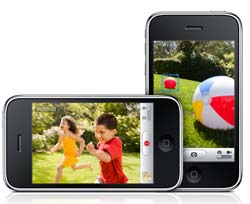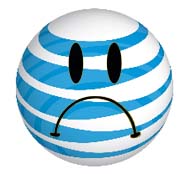 If you ask Apple or AT&T how much the iPhone 3G S costs, they’ll emphasize two prices: $199 for the 16GB version and $299 for the 32GB one, as Apple does here. It’s only in the fine print and disclaimers that they’ll explain that only new customers and those who aren’t on a contract (or nearing the end of one, at least) qualify for those deals. Which means that all of us who bought AT&T iPhone 3Gs upon their release a little under a year ago don’t qualify–we’ll pay $399 for the 16GB model or $499 for the 32GB one, assuming we’re willing to extend our contracts for another two years. Which still represents a discount off the no-commitment pricing: $599 for 16GB and $699 for 32GB.
If you ask Apple or AT&T how much the iPhone 3G S costs, they’ll emphasize two prices: $199 for the 16GB version and $299 for the 32GB one, as Apple does here. It’s only in the fine print and disclaimers that they’ll explain that only new customers and those who aren’t on a contract (or nearing the end of one, at least) qualify for those deals. Which means that all of us who bought AT&T iPhone 3Gs upon their release a little under a year ago don’t qualify–we’ll pay $399 for the 16GB model or $499 for the 32GB one, assuming we’re willing to extend our contracts for another two years. Which still represents a discount off the no-commitment pricing: $599 for 16GB and $699 for 32GB.
Some folks are irate at this turn of events, arguing that the pricing punishes loyal AT&T customers. Nope. What it does is prevent customers who got a steep discount on an iPhone a year ago in return for signing up for a two-year contract to get an equally steep discount this year for signing up for another two-year contract. Which strikes me as perfectly reasonable, given that this scenario involves you only being under contract to AT&T for a total of three years. You can still get a discount on a new iPhone–just not one that’s as steep as someone who commits to AT&T for a total of four years.
Come to think of it, the math is perfectly logical: You get a total of $400 in discounts (on one phone) for two years of commitment, $600 in discounts (on two phones) for three years of commitment, and $800 in discounts (on two phones) for four years of commitment. That’s a $200 discount per year of contract you fulfill.
(Why doesn’t AT&T let iPhone 3G owners get a $199 iPhone 3G S today in return for agreeing to fulfill their original two-year contract and extend it for an additional two years? I’m not sure. But I’m wary of long-term commitments to any wireless character, and therefore wouldn’t endorse a scenario which involves agreeing to marry AT&T until at least 2012 in order to get a discount on a phone.)
If there’s a problem here, it’s the way phones are usually sold in America, via subsidies that encourage us to think that phones cost less than they really do, and which tie us up with a carrier and prevent us from moving a phone we’ve bought to another carrier (even temporarily, when we’re overseas). A top-of-the-line iPhone really costs $699, which is not a crazy price given its capabilities; it’s just that very few of us ever pay that price or even realize it exists. We’re conditioned to think of those subsidized prices as the prices, in part because phone manufacturers and carriers stress them above all else.
So no, I’m not that sympathetic towards iPhone 3G owners who want AT&T to sell them the iPhone 3G S at the same sweetheart price as someone who didn’t buy an iPhone 3G last year. You agreed to fulfill a two-year contract with AT&T in return for the discount you got last year. AT&T is willing to renegotiate it and give you a proportionate discount on a 3G in return for another year of commitment. Explain to me again what’s offensive about that?
 I swear that I’m not trying to turn Technologizer into an AT&T bashfest. But I’ve spent part of my afternoon girding myself to get an iPhone 3 GS. I’m ready to pre-order and pay up. So far, though, I’m just confused.
I swear that I’m not trying to turn Technologizer into an AT&T bashfest. But I’ve spent part of my afternoon girding myself to get an iPhone 3 GS. I’m ready to pre-order and pay up. So far, though, I’m just confused.
 Wow. My post contending that
Wow. My post contending that  Ready to partake in news?
Ready to partake in news? Here’s another
Here’s another  If you ask Apple or AT&T how much the iPhone 3G S costs, they’ll emphasize two prices: $199 for the 16GB version and $299 for the 32GB one, as
If you ask Apple or AT&T how much the iPhone 3G S costs, they’ll emphasize two prices: $199 for the 16GB version and $299 for the 32GB one, as  Quick, you guys: Quit your jobs, team up with each other, and form a research firm specializing in Apple punditry. As a group, your predictions would likely be significantly closer to being on-target than those of a bunch of well-known analyst firms where serious moolah is made guessing what Steve Jobs and company are working on.
Quick, you guys: Quit your jobs, team up with each other, and form a research firm specializing in Apple punditry. As a group, your predictions would likely be significantly closer to being on-target than those of a bunch of well-known analyst firms where serious moolah is made guessing what Steve Jobs and company are working on. So much about Apple’s new iPhone was revealed through rumor ahead of time that I
So much about Apple’s new iPhone was revealed through rumor ahead of time that I